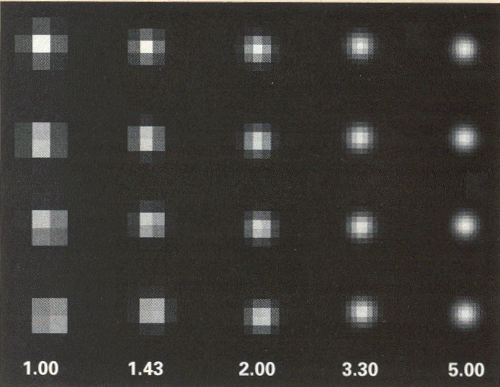![]()
The considerations that we are going to do, concern the optimization of the telescope with the CCD camera, in particular the relationship which must exist between focal length and pixel dimension.
As for all the optic systems, the THEORETICAL limit is given by the refraction of the light, we will therefore refer to the disc of Airy which represents the dimension of an image produced by a punctiform object, in this case a star. If only the first ring is considered, the diameter of this is given by:
Airy diam. = wavelenght x focal ratio
By replacing the dimension of the pixel insted of the diameter value and by applying at least a 2 x sampling (Nyquist theorem), we obtain:
f = 2 * pix / lambda
where:
f = focal ratio
pix = pixel dimension.
lambda = wavelength of the light
Example: to get the maximum of space resolution from a camera which equips a KAF400 (9 um pixel) and by taking into consideration a wavelength of 500 nm, we will have:
f = 9 = 2 x 9 / 0.5
All this is pure theory as there are many other factors which affect the measure and in particular the atmospheric seeing (turbulence).
The field framed by a single pixel is instead given by:
ps = 206264 / f * pix
where:
ps = angle in second of arc subtended by a pixel.
f = focal length of the telescope in mm
pix = pixel dimension in mm
A telescope with a focal of 2000 mm connected with a Discovery 260, will give for instance:
2" = 206264 / 2000 * 0.02
The real number of involved pixels will be instead given by:
np = seeing / ps
The shootted field by the CCD sensor is given by:
field = ps * npix
Where npix is the number of present pixels on the considered axis.
In case of the photometric measures, it is recommended to sample a star by a minimum of 3 x3 pixels and optimally of 5x5 pixels.
![]()
Le considerazioni che andiamo a fare riguardano l'ottimizzazione del telescopio con la camera CCD in particolare il rapporto che deve esistere fra lunghezza focale e dimensione del pixel.
Come per tutti I sistemi ottici il limite TEORICO e' dato dalla rifrazione della luce, faremo quindi riferimento al disco di Airy che rappresenta la dimensione di una immagine prodotta da un oggetto puntiforme, in questo caso una stella. Se si considera solo il primo anello il diametro di questo e' dato da:
Airy diam. = wavelenght x focal ratio
Sostituendo al valore del diametro la dimensione del pixel ed applicando almeno un campionamento 2X (teorema di Nyquist), otteniamo:
f = 2 * pix / lambda
dove:
f = focal ratio
pix = dimensione del pixel
lambda = lunghezza d'onda della luce
Esempio: per ottenere il massimo di risoluzione spaziale da una camera che equipaggia un KAF400 (pixel 9um) e considerando una lunghezza d'onda di 500 nm avremo:
f = 9 = 2 x 9 / 0.5
Tutto questo e' pura teoria in quanto ci sono molti altri fattori che vanno ad influenzare la misura ed in particolare il seeing (turbolenza) atmosferico.
Il campo inquadrato da un singolo pixel e' invece dato da:
ps = 206264 / f * pix
dove:
ps = angolo in secondi d'arco sotteso da un pixel.
f = lunghezza focale del telescopio in mm
pix = dimensione del pixel in mm
Ad esempio un telescopio con una focale di 2000mm accoppiato con una Discovery 260 dara':
2" = 206264 / 2000 * 0.02
Il reale numero di pixel coinvolti sara' invece dato da:
np = seeing / ps
Ovviamente il campo inquadrato dal sensore CCD sara' dato da:
field = ps * npix
Dove npix e' il numero di pixel presenti sull'asse considerato.
Nel caso delle misure fotometriche si raccomanda che una stella sia campionata da un minimo di 3x3 pixel ed ottimale un 5x5 pixel.


